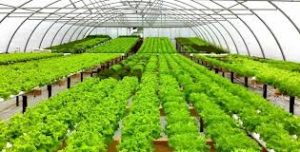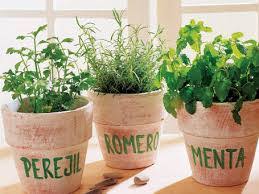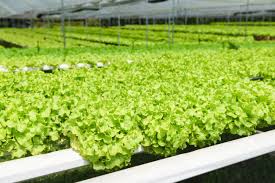Hydroponic Plants is a cultivation using (utilizing) water without using soil and emphasizing the growing nutritional needs for plants. Water requirements for hydroponic plants are less when compared to water requirements in aquaculture using soil media. Hydroponic plants use water more efficiently, so it is best if it is applied to areas that have limited water supply.

Etymologically, hydroponics ( hydroponic ) is derived from the Greek words ” hydro” meaning water and ponos means power. Hydroponics is also known as soil culture . So hydroponics is defined as the cultivation of plants that use water and without using soil as a planting medium or soilles.
Hydroponic planting technique itself is an environmentally friendly farming technique.Vegetables or fruit plants that are planted in a hydroponic way are healthier and safer for consumption. Some people may still not be familiar with hydroponic plants. But, actually there are also many people who have switched to using this method of planting crops.
Cultivation of engineering plants like this can be said to have not experienced rapid development. This is because there are still many people who are hesitant to implement it and are worried about the quantity of their crops. But, in fact the yields from hydroponic growing techniques have good quality and quantity.
This planting technique without using soil media is suitable for those of you who have limited land. Because this technique does not require large tracts of land, it is sufficient with a little planting medium.
Likewise if you have less fertile land, planting techniques can be an option, so that it helps get a satisfying harvest. Hydroponic planting techniques are applied using easily grown plants such as tomatoes , melons , chilies and spinach, carrots, potatoes , spring onions and so on.
5 Hydroponic Planting Techniques

The hydroponic planting technique has several planting methods, including:
- Hydroponic Aggregate Culture
This technique is a hydroponic planting technique that uses sand, gravel, rice husk, charcoal as well as sterilized materials.
- Hydroponic Water Culture
Water culture hydroponic planting techniques are applied using micro and macro nutrient solutions. Where planting is carried out on a medium and the solution is placed at the bottom. The goal is that plant roots can absorb and touch the solution that is rich in nutrients.
- Hydroponic Nutrient Film Technique
This hydroponic planting technique is carried out in a narrow and long gutter. Growing media can be made of thin metal plates but non-rust. Furthermore, the gutter will be nourished through water to be absorbed by planted plants. Slowly, a thin layer called a film will appear around the root area of the plant. The function of the film is to feed the hydroponic plant.
Things To Look For When Planting Hydroponic Plants
Before planting using hydroponic planting techniques, there are a number of things to consider so that hydroponic plants can grow well, including:
-
- Growing media
The planting medium used for hydroponic techniques is to use a planting medium with sufficient moisture and nutrients. Not only that, the best growing media for hydroponic planting techniques must have good drainage. Thus, free from toxic substances and harmful to plants.
-
- Water
Water is the most important element for hydroponic plants to optimize their growth. The quality of plants and the amount of hydroponic crop yields depend very much on this one element.
-
- Nutrient
Nutrient is an element that is no less important in the growth of hydroponic plants. Hydroponic plants need enough nutrients to grow and develop properly. It is advisable to add nutrient solutions to hydroponic plants regularly.
-
- Oxygen
Oxygen is also another element in hydroponic planting techniques that must be considered. Do not let hydroponic plants get low oxygen levels. Because this condition can cause cell walls to be difficult to penetrate. This can be bad for plants. Plants can wither and lack water which makes them more at risk of dying.
Types of Hydroponic Plants That Can Be Grown at Home

Not all types of plants can be planted using hydroponic techniques. Here are some suitable types of plants grown using hydroponic techniques, including:
-
- Lettuce
Lettuce is one type of vegetable that can be grown using hydroponic techniques. These vegetables can flourish by using hydroponic planting techniques. In addition, care for this plant is fairly easy. Does not require extra care to cultivate lettuce plants. Therefore, lettuce is widely cultivated by the hydroponic method.
When seeding is sown, one week later the plant will appear 2 sheets of leaves. Then transferred to the main media with adequate nutrition, the growth will be faster. Tips for those who want to cultivate lettuce with a hydroponic planting technique that is able to cut the outer leaves so that the inner leaves will flourish replacing the leaves you have cut.
-
- Strawberry
Strawberry is one type of fruit plant that can be cultivated and grows well using the hydroponic system. Strawberry has high antioxidant and vitamin C which is good for body immunity. This subtropical plant can also help in lowering cholesterol and high blood pressure.
-
- Cucumber
Cucumber is also a type of hydroponic plant that can be cultivated. This plant requires extra attention to get a good harvest. If not given extra attention, it is difficult for cucumbers to flourish and bear fruit quickly.
Cucumbers require adequate sunlight, and therefore many hydroponic farmers grow them in greenhouses. In addition, cucumbers also require a larger place if it has begun to grow large, you should use a large plastic bottle as a growing medium. That way, cucumbers can flourish with perfect shape and maximum yield.
-
- Melon
Besides strawberries, the fruit that can also be planted using hydroponic techniques is melon. To plant melons . The thing to note is the lighting and nutrition of the water. Melon planting requires large planting media because these plants can grow large.
-
- Tomato
Tomatoes are fruits that are rich in vitamins A, C, and folic acid. In addition, tomatoes also contain high antioxidants that help protect against the risk of heart disease, diabetes and cancer. Tomatoes are more ideal if planted outdoors, because to support the nature of its growth which propagates, then a buffer in the form of wood or iron is needed.
-
- Paprika
Paprika is not only used as a flavor enhancer in cooking or as a food supplement but paprikan which has Lycopene compounds, vitamins A and C, is very good at preventing cancer, increasing immunity and maintaining eye health. Basically hydroponic paprika cultivation techniques are almost the same as other hydroponic plants, it’s just that the treatment of some types of plants will be slightly different due to the characteristics of the plant itself.
-
- Herbal plant
In addition to fruits and vegetables, types of plants that can be planted using hydroponic techniques are herbal plants. Can grow it yourself at home, herbs that can be planted hydroponically include basil, coriander and mint leaves.
Hydroponic system deficiencies:
-
- Requires a large capital
- In substrate culture, the capacity of holding substrate media water is smaller than the soil media so that it will cause rapid withering of plants and serious stress.
- Need more planting media, although you could say more simple because it only prioritizes water for nutritional needs.
Cultivation
Growing hydroponic plants can be done with the following simple steps
-
- Seeding Seeds
The first step is to sow seeds. For example, if you plant hydroponic chilies, it is enough to use seeds from chilies in the kitchen. Choose a good chili, old and of course there are no diseases, pay close attention.
Then, split the chillies and just take the seeds for seeding. Hydroponic chilli seeding can use seed media in the form of a mixture of soil, husk charcoal and compost or manure with a ratio of 1: 1: 1. Next place the hydroponic seeds in the seedling media with a distance between the seeds that is 3 × 3 cm, then cover with just enough fine soil.
For watering, enough to use a sprayer, wet the seedlings sufficiently. Wait for seeds for about 5 to 7 days, and see if the seeds have sprouted.
-
- Prepare the planting media
The next step is preparing the planting media. The planting media can use cocopeat (coconut fiber powder) and charcoal husks in a ratio of 1: 1. Mix the two ingredients evenly together then also prepare the wick because hydroponic planting is by the Mick system.
Axes that can be used come from flannel, this fabric has a very high absorption. With high absorption, nutrients can get well into the planting media.
-
- Prepare the Nutrition and Pot reservoir
Nutritional reservoirs and pots can also be made from used items such as jars or used cups.
-
- Planting Seeds
Next, remove the seedlings that have been sown at 25 to 30 days after sowing. Carefully carry out transplanting so that the seedlings do not break or are damaged. Flush the seedling media using water before pulling or gouging out. After that, you can pull out the seeds and plant them in the planting medium. However, make sure the seedling roots are clean from the seedling media, you can wash them very carefully first. The seeds can be planted in pots and then filled with enough water.
If so, you can put the plant in the shade. Make sure you pay attention to the growing media, don’t dry it. If it has started to decrease, flush the growing media using water.
Leave the plant for about 1 week in the shade. After that, introduce hydroponic chilli plants with sunlight gradually, only slowly.
-
- Give Nutrition
Furthermore, also provide adequate nutrition for hydroponic chilli plants to support its growth. Nutrients that can be given are AB Mix nutrition, created specifically for hydroponic plants. When seedlings are 5 to 7 days after planting, they can provide these nutrients. Use 600 to 700 ppm or about 5 ml of nutrient A, 5 ml of nutrient B and 1 liter of water.
-
- Maintenance
The last thing to consider in hydroponic planting techniques is maintenance. What must be done is to meet the nutritional needs and protect plants from diseases and pests. Therefore, be diligent to check the availability of nutrient solutions in the growing media. When it begins to decrease, flush with a nutrient solution so that plants can flourish and not die.
Meanwhile, pests and diseases that are at risk for hydroponic plants are aphids, caterpillars, mites, spots and so forth. So that the hydroponic plants need to be occupied by micronutrients, spray the plants once a week with leaf fertilizer. Spraying using leaf fertilizer can be done in a period of vegetative growth.
